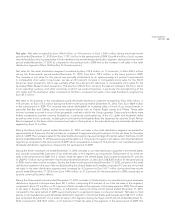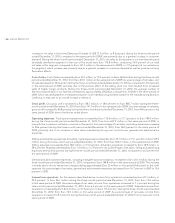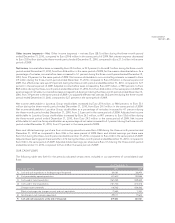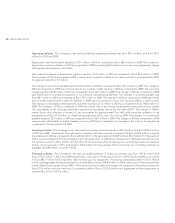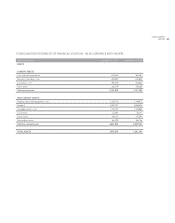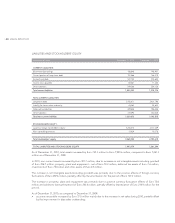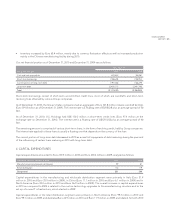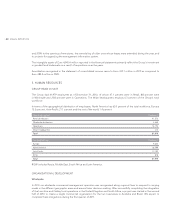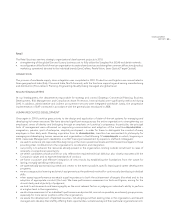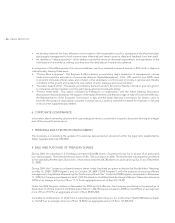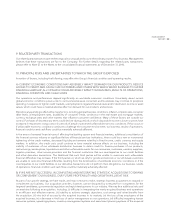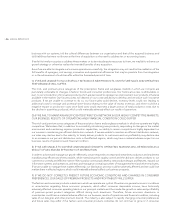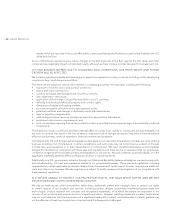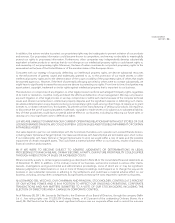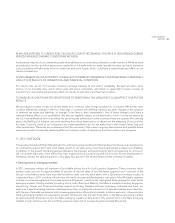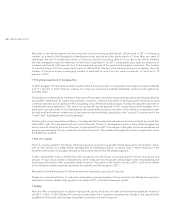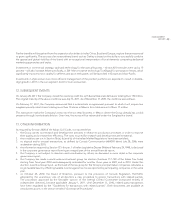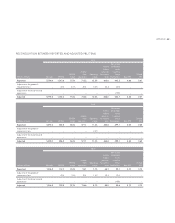LensCrafters 2010 Annual Report Download - page 57
Download and view the complete annual report
Please find page 57 of the 2010 LensCrafters annual report below. You can navigate through the pages in the report by either clicking on the pages listed below, or by using the keyword search tool below to find specific information within the annual report.|55 >
MANAGEMENT
REPORT
9. RELATED PARTY TRANSACTIONS
Our related party transactions are neither atypical nor unusual and occur in the ordinary course of our business. Management
believes that these transactions are fair to the Company. For further details regarding the related party transactions,
please refer to Note 27 to the Notes to the consolidated financial statements as of December 31, 2010.
10. PRINCIPAL RISKS AND UNCERTAINTIES TO WHICH THE GROUP IS EXPOSED
A number of factors, including the following, may affect the Group’s financial condition and operating results.
A) CURRENT ECONOMIC CONDITIONS MAY ADVERSELY IMPACT DEMAND FOR OUR PRODUCTS, REDUCE
ACCESS TO CREDIT AND CAUSE OUR CUSTOMERS AND OTHERS WITH WHICH WE DO BUSINESS TO SUFFER
FINANCIAL HARDSHIP, ALL OF WHICH COULD ADVERSELY IMPACT OUR BUSINESS, RESULTS OF OPERATIONS,
FINANCIAL CONDITION AND CASH FLOWS
Our operations and performance depend significantly on worldwide economic conditions. Uncertainty about current
global economic conditions poses a risk to our business because consumers and businesses may continue to postpone
spending in response to tighter credit markets, unemployment, negative financial news and/or declines in income or asset
values, which could have a material adverse effect on demand for our products and services.
Discretionary spending is affected by many factors, including general business conditions, inflation, interest rates, consumer
debt levels, unemployment rates, availability of consumer credit, conditions in the real estate and mortgage markets,
currency exchange rates and other matters that influence consumer confidence. Many of these factors are outside our
control. Purchases of discretionary items could decline during periods in which disposable income is lower or prices have
increased in response to rising costs or in periods of actual or perceived unfavorable economic conditions. If this occurs or
if unfavorable economic conditions continue to challenge the consumer environment, our business, results of operations,
financial condition and cash flows could be materially adversely affected.
In the event of renewed financial turmoil affecting the banking system and financial markets, additional consolidation of
the financial services industry or significant failure of financial services institutions, there could be a new or incremental
tightening of the credit markets, decreased liquidity and extreme volatility in fixed income, credit, currency and equity
markets. In addition, the credit crisis could continue to have material adverse effects on our business, including the
inability of customers of our wholesale distribution business to obtain credit to finance purchases of our products,
restructurings, bankruptcies, liquidations and other unfavorable events for our consumers, customers, vendors, suppliers,
logistics providers, other service providers and the financial institutions that are counterparties to our credit facilities
and other derivative transactions. The likelihood that such third parties will be unable to overcome such unfavorable
financial difficulties may increase. If the third parties on which we rely for goods and services or our wholesale customers
are unable to overcome financial difficulties resulting from the deterioration of worldwide economic conditions or if the
counterparties to our credit facilities or our derivative transactions do not perform their obligations, our business, results
of operations, financial condition and cash flows could be materially adversely affected.
B) IF WE ARE NOT SUCCESSFUL IN COMPLETING AND INTEGRATING STRATEGIC ACQUISITIONS TO EXPAND
OR COMPLEMENT OUR BUSINESS, OUR FUTURE PROFITABILITY AND GROWTH WILL BE AT RISK
As part of our growth strategy, we have made, and may continue to make, strategic business acquisitions to expand or
complement our business. Our acquisition activities, however, can be disrupted by overtures from competitors for the
targeted candidates, governmental regulation and rapid developments in our industry. We may face additional risks and
uncertainties following an acquisition, including: (i) difficulty in integrating the newly–acquired business and operations
in an efficient and effective manner; (ii) inability to achieve strategic objectives, cost savings and other benefits from
the acquisition; (iii) the lack of success by the acquired business in its markets; (iv) the loss of key employees of the
acquired business; (v) a decrease in the focus of senior management on our operations; (vi) difficulty integrating human
resources systems, operating systems, inventory management systems and assortment planning systems of the acquired


